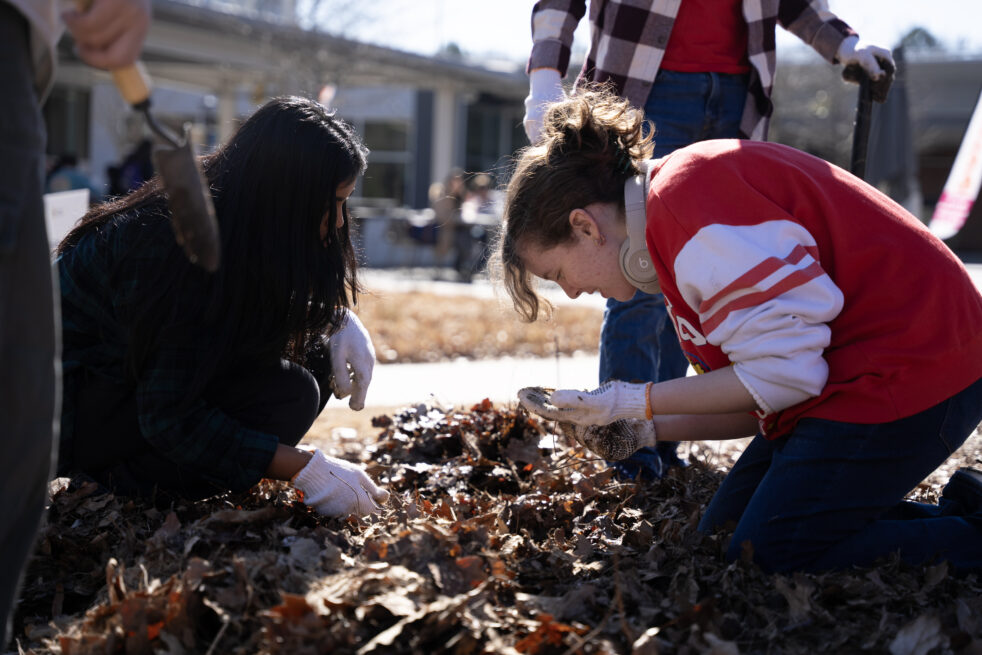On Feb. 6, the Students Organizing for Sustainability (SOS) Community Garden became home to 500 new daffodil bulbs through a collaborative gardening event with The Daffodil Project.
The Daffodil Project is a worldwide organization working to create a dynamic memorial in the form of planting 1.5 million daffodils around the planet in remembrance of the 1.5 million children who died during the Holocaust. The organization’s primary focus is on raising awareness of the Holocaust and educating people about genocide interactive planting programs.
Eli Winterscheidt, fourth-year MSE, is the Community Garden Director within the SOS. He explains more about how this recent collaboration project came to be.
“I’ve been a part of quite a few plantings with [the Daffodil Project] in different locations. They partner with all sorts of different communities, and as long as those communities put in at least 500 bulbs, 250 are provided by the organization and 250 are provided by the project. It’s a great way to remember people. I saw the daffodils popping up around campus and thought, you know, this would be a great place to put some down there in the garden,” Winterschiedt said.
As the Community Garden Director, Winterschiedt is in charge of planning, maintaining and organizing everything relating to the Community Garden, including weekend workdays, where students learn about gardening, special events and other administrative responsibilities such as the recent renovation.
“I’m not 100% sure where its first iteration was. That’s something I’ve been trying to find out for about three years, but it moved to the current location about 15 years ago now. Since then, there’s been a lot of different changes; so it started out very small with just six beds, then in 2018 they built a fence around the perimeter of the garden and then starting in 2022 we had a full-scale renovation that tripled our size on campus,” Winterschiedt said.
Last year’s renovation allowed the Community Garden to expand its own land, grow more plants and crops and open the garden for other on-campus organizations, graduate students and faculty to utilize them.
“One thing that we do that is special is that most of our garden is operated just by SOS, our eleven large plots, but we have a lot of small plots that are available to be rented by anyone who’s not an undergraduate student, so graduate students, faculty or staff. They’d pay $15 per semester if they wanted to have their own plot to grow plants,” Winterscheudt explained.
Opening the garden plots for public use is just one of the several ways that SOS is working to encourage the community and expand its outreach on campus with different organizations. Winterscheidt described more about the larger goals and vision that the leadership holds for SOS.
“A big part of the Community Garden is the community. I really love emphasizing that, so whether that’s with our donations to Klemis Kitchen through the garden or with our community cooking events for things outside of the garden, I mean SOS operates through a lot of different channels,” Winterscheidt said.
Their involvement extends beyond just the perimeter of the garden fence. SOS projects focus on encouraging environmental sustainability in all sectors of campus life. These diverse target goals allow many different people to join SOS for values and issues that are important and personal to them.
“We have projects that focus on wildlife safety on campus and focus on waste management on campus especially with the zero waste project that’s going on and then we have some more organizing projects, especially with the election year, towards getting more environmentally minded voters out there,”
Winterscheidt said.
While they are often more attention catching, larger, planned events such as the recent Daffodil Project collaboration are not the only way for students to get involved with the garden.
Even just spending some time around the plants and flowers is a great way to immerse oneself and gain an appreciation for the vast stretches of quiet nature on the Institute’s busy campus.
“The garden is open for everyone just to come in and hang out. That’s something that we’ve had issues getting across; people see the closed gates that they think it’s a barrier, but it’s just because they can’t swing around with the wind,” Winterscheidt said on the garden’s usage and access.
The Community Garden hosts workdays every Saturday from 9-11 a.m., where students can learn about planting, harvesting and gardening techniques and tools. “Depending on the weather, of course, we’re going to start planting for the spring this weekend and all through March hopefully,” Winterscheidt said.
Those interested can check out the SOS Instagram @sos.gatech for future events and to get involved with the organization and the Community Garden. Learn more about The Daffodil Project and Holocaust education at daffodilproject.net/.
